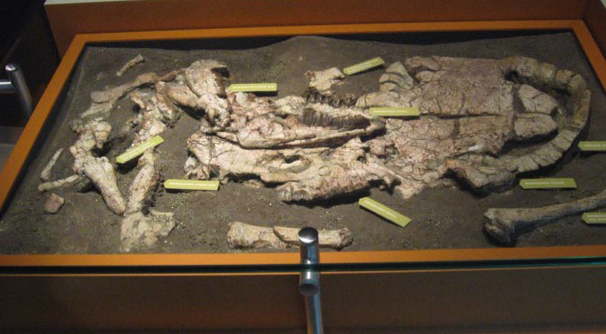This post is an overview of the fossil record of the transition of reptiles to turtles and tortoises. Knowledge of this transition is changes because new data are always being discovered. The following chart (oldest age at the bottom, youngest age at the top) depicts the successive development of early reptiles that led to tortoises.
Captorhinids have long been the candidates for the initial evolutionary step in transitioning from reptiles to turtles. An example, depicted in Figure 1, is the captorhinid Labidosaurus hamatus, 30 inches long, Late Pennsylvanian age, and from Texas. It strongly resembles a lizard. My drawing is modified from an image shown in: en.Wikipedia.org.
Figure 1: captorhinid Labidosaurus hamatus
_________________________________________________________
Following the captorhinids were the pariasaurs. An example, depicted in Figure 2 below, is Scutosaurus karpinskii, up to 6 ft. long and 500 pounds. This pariasaur genus represents “shield reptiles” because they were armored with bony osteoderms in their skin in order to resist bites by predators. Just like other early reptiles, Scutosaurus karpinskii had an anapsid skull (i.e., no temporal openings in it in order to accommodate bulging jaw muscles. This animal was a plant eater that lived in semi-arid climates. My drawing is modified from an image shown in: en.Wikipedia.org.
Figure 2: a pareiasaur, Scutosaurus karpinskii––––––––––––––––––––––––––––––––––––––––––––––––
The next evolutionary group (Figure 3) is represented by Proganochelus quenstedti, about 3 ft. long (1 m). This fossil, which is Triassic in age, represents a primitive stem turtle because it has a fully developed carapace and plastron (a protective breastplate—which all modern turtles have).
Figure 3: Proganochelus quenstedti
______________________________________________________
The largest known sea turtle of all time is Archelon ischyros. This species was as big as 15 ft. long (4–6 m) and weighed about 2.4-3.5 tons. The specimen illustrated below (Fig. 5) is about 12 feet long and from the Pierre Shale in the Black Hills of South Dakota. It is a famous specimen and stored in the Yale Peabody Museum. The specimen is of Late Cretaceous age (Campanian/Maastrichtian).
This is a public domain image.Figure 5: Archelon ischyros
________________________________________________
The final image in this series shows a tortoise skeleton, of Oligocene age from the non marine Sespe Formation, Las Posas Hills, Ventura County, Southern California. This is a rare find!
Figure 6, A disarticulated tortoise skeleton.
References
Cadena, E.A. and J.F. Parham. 2015. Oldest known marine turtle? A new protostegid from the Lower Cretaceous of Colombia. PaleoBios 32:1–42.
En.Wikipedia.org [2023].







This is quite interesting. Thank you for posting! I will share it with my students.
ReplyDelete